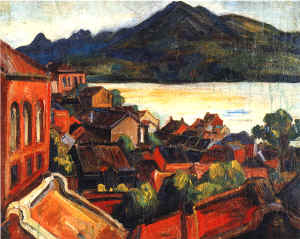=> HOME of Structured Data for Bios
陳植棋 Chen Zhiqi
|
Structured DataChen Zhiqi
陳植棋
ISNI 0000 0000 6433 8685
Tân Si̍t-kî
Chen Chihchi
Painter
http://vr.theatre.ntu.edu.tw/fineart/painter-tw/chenchihchi/chenchihchi.htm
https://en.wikipedia.org/wiki/Chen_Zhiqi
https://zh.wikipedia.org/wiki/%E9%99%B3%E6%A4%8D%E6%A3%8B
Chen Zhiqi (Chinese: 陳植棋, 1906.01.16~1931.04.13), a painter. In April of 1931, he passed away in Taipei. He was only 26 years old. In September of the same year, a posthumous exhibition of Chen’s works was held in his honor at the former building of Taiwan Governor-General's Office.
Born: 1906-01-16
Hengke, Xizhi, Taipei, Taiwan
Died: 1931-04-13
Taipei, Taiwan
Nationality: Japanese
Relations: Alumni of: Taipei Normal School
Alumni of: Hongo Painting Institute
Alumni of: Tokyo School of Fine Arts
Alumni of: Yoshimura Painting Studio
Follows: Ishikawa Kinichiro
Follows: Yoshimura Yoshimatsu
Follows: Shiotsuki Toho
Knows: Li Shiqiao
Knows: Hong Ruilin
Knows: Zhang Wanchuan, and Chen Dewang
Knows: Chen Dewang
Important Roles: Creator of: Tamsui Scenery (painting)
Founder of: Chi-Hsing Painting Society
Founder of: Chidao Association
Award and recognition: Tamsui Scenery selected for the 11th Imperial Art Exhibition.
|
Sources and references
- 葉思芬,〈英雄出少年—天才畫家陳植棋〉,《臺灣美術全集14‧陳植棋》,臺北市:藝術家出版社,1992,頁15-52。
- 顏娟英,〈殿堂中的美術─臺灣早期現代美術與文化啟蒙〉,《中央研究院歷史語言研究所集刊》64:2(1993),頁469-610。
- Starting Out from 23.5°N: Chen Cheng-po, Academia Sinica Digital Center (ASDC). http://chenchengpo.asdc.sinica.edu.tw/friend_en
© Marcia Lei Zeng for Academia Sinica Center for Digital Cultures
